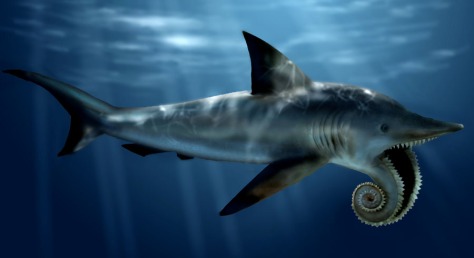Kaprosuchus saharicus ancestor of Crocodile

Kaprosuchus is known from only a single almost complete skull discovered in Niger. This crocodyliform was nicknamed “boar croc” after its unusual caniniform teeth which resemble those of a boar. It has been estimated that Kaprosuchus may have reached lengths of 6 metres. It is thought that this crocodyliform would have been strictly a terrestrial (living on land) animal and certainly a feared predator!
Titanoboa ancestor of snake

Titanoboa, meaning “titanic boa,” is an extinct genus of snake that lived approximately 60–58 million years ago, during the Paleocene epoch,a 10-million-year period immediately following the dinosaur extinction event. The only known species isTitanoboa cerrejonensis, the largest, longest, and heaviest snake ever discovered, which supplanted the previous record holder,Gigantophis. By comparing the sizes and shapes of its fossilized vertebrae to those of extant snakes, researchers estimated that the largest individuals of T. cerrejonensis found had a total length of around 12.8 m (42 ft) and weighed about 1,135 kg (2,500 lb; 1.1 long tons).
Megatherium prehistoric ancestor of sloth

Megatherium from the Greek mega [μέγας], meaning “great”, and therion [θηρίον], “beast”) was agenus of elephant-sized ground sloths endemic to South America that lived from the late Pliocene through the end of the Pleistocene. Its size was exceeded by only a few other land mammals, including mammoths and Paraceratherium.
Helicoprion prehistoric ancestor of shark

Helicoprion is a long-lived genus of extinct, shark-like eugeneodontid holocephalid fish. Almost all fossil specimens are of spirally arranged clusters of the individuals’ teeth, called “tooth whorls.” Helicoprion first arose in the oceans of the late Carboniferous310 million years ago, survived the Permian–Triassic extinction event, and eventually became extinct during the Early Triassic,250 million years ago. The closest living relatives of Helicoprion (and other eugeneodontids) are the chimaer
Deinotherium Prehistoric ancestor of elephants


Deinotherium (“terrible beast” derived from the Ancient Greek δεινός, deinos meaning “terrible” and θηρίον, therion meaning “beast”) was a large prehistoric relative of modern-day elephants that appeared in the Middle Miocene and survived until the Early Pleistocene. During that time it changed very little. In life, it probably resembled modern elephants, except that its trunk was shorter, and it had downward curving tusks attached to the lower jaw.
Gigantopithecus

Gigantopithecus (from the Ancient Greek “giant”, and “ape”) is an extinct genus of ape that existed from perhaps nine million years to as recently as one hundred thousand years ago, in what is now Nepal, China, India, and Vietnam, placing Gigantopithecus in the same time frame and geographical location as several hominin species. The fossil record suggests that individuals of the species Gigantopithecus blacki were the largest known apes that ever lived, standing up to 3 m (9.8 ft), and weighing up to 540 kg (1,190 lb)
